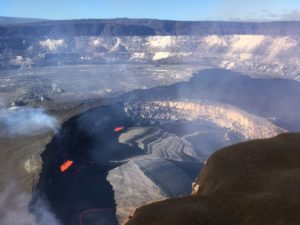Scientists Explain Halema‘uma‘u’s Lava Lake Levels

On January 8, 2018, Kīlauea Volcano’s summit lava lake level was 125 ft below the rim of “Overlook crater,” the small crater that formed above the active vent in Halemaʻumaʻu. The lava lake continuously emits elevated levels of sulfur dioxide gas and erupts small, but measurable, amounts of Pele’s hair and other ash-sized tephra (airborne lava fragments) that accumulate on the rim of Halemaʻumaʻu (lower right) and areas downwind of the lake. USGS photo by J. Sutton.
About a year ago, the lava lake within Halema‘uma‘u at Kīlauea Volcano’s summit was high enough that spattering on the lake surface was commonly visible from the Jaggar Museum overlook in Hawaiʻi Volcanoes National Park. Although nighttime glow from the lava lake remains impressive, direct views of spattering lava are now less common, because the lake level has gradually dropped since that time.
The lake level is constantly changing, and it fluctuates over many different timescales, from minutes to months. So what causes the lake level to rise and fall?
To answer this question, USGS Hawaiian Volcano Observatory scientists have been closely observing the lava lake behavior and making careful, regular measurements of the lake level. A key to understanding the processes that control lake level is to compare the lake level measurements to other monitoring parameters, such as gas emission rates, ground tilt, and seismic tremor. Direct visual observations of lake activity are also essential.
With several years of such data, we can show that the lake level is related to two main factors: magma chamber pressure and gas emission rates.
Magma chamber pressure is the main control on the lava lake level. On a day-to-day basis, the lake level rises and falls in concert with the volcano’s deflation-inflation cycles. Deflation results in lava levels dropping as much as 20 yards over several days, with inflation leading to lake level rise.
Over longer time periods, such as months to years, magma chamber pressure is affected by the rate of magma supply from deeper levels. For example, an apparent increase in magma supply rate in early 2016 caused the volcano to inflate slightly and drove the lake higher. The decline in the lake level over the past year might relate to a slight decrease in magma supply rate.
The close correlation between magma chamber pressure and lava lake level means that the lake can be thought of as a “barometer” for the underlying magma chamber.
The lake provides a tool for judging the pressure state of the volcano, which is potentially useful for anticipating future eruptive events on Kīlauea’s rift zones. For example, the lake rose to high levels just before the March 2011 Kamoamoa fissure eruption near Pu‘u ‘O‘o on the volcano’s East Rift Zone.
The pressure of the summit magma chamber also determines the rate at which magma is flowing to Pu‘u ‘Ō‘ō on the East Rift Zone. Higher lake levels in Halema‘uma‘u normally mean elevated lava supply rates at the Pu‘u ‘Ō‘ō vent, and potentially more vigorous lava flows. So tracking the lake level can be another tool for forecasting lava flow hazards on the East Rift Zone.
Gas emission rate is the other main control on the Halema‘uma‘u lava lake level. Increases in the gas emission rate from the lake relate to increases in the amount of spattering on the lake surface. Releasing more gas from the lake results in a slight drop in lake level, normally of a few yards. Unlike the lava level changes due to magma chamber pressure, these gas-driven changes normally occur over much shorter time periods, ranging from minutes to hours.
HVO scientists normally measure the lake level with a handheld laser rangefinder, but new tools for tracking lava lake level are on the horizon. University of Cambridge scientists are currently testing a radar system to continuously measure Kīlauea’s summit lava lake level with high precision. Stereo cameras are also being tested this month to track the lake level, as well as changes in crater and lake dimensions.
The level of the Halema‘uma‘u lava lake is a simple indicator of the pressure state of Kīlauea’s magma chamber, and the lake provides a “window” for peering into the volcano’s interior. The lake has provided another useful tool to add to HVO’s monitoring toolbox.
Volcano Activity Updates
This past week, Kīlauea Volcano’s summit lava lake level fluctuated with summit inflation and deflation, ranging about 98–154 ft below the vent rim. On the East Rift Zone, the 61g lava flow remained active downslope of Pu‘u ‘Ō‘ō, with scattered breakouts on the pali and coastal plain, but no ocean entry. The 61g flows do not pose an immediate threat to nearby communities.
Mauna Loa is not erupting. Rates of deformation and seismicity remain above long-term background levels, but rates are decreased from earlier in the year. Similar decreases have occurred in the past during the ongoing period of unrest; it is uncertain if these lower rates will persist or will pick up again in the near future. Small-magnitude earthquakes occurred beneath the summit caldera and upper Southwest Rift Zone at depths less than 3 miles. A few deeper earthquakes were scattered beneath the volcano’s southeast flank at depths of 3‒8 miles. GPS and InSAR measurements continue to show deformation related to inflation of a magma reservoir beneath the summit and upper Southwest Rift Zone. No significant changes in volcanic gas emissions were measured.
No earthquakes were reported felt on the Island of Hawaiʻi this past week.
Volcano Watch is a weekly article and activity update written by US Geological Survey Hawaiian Volcano Observatory scientists.










